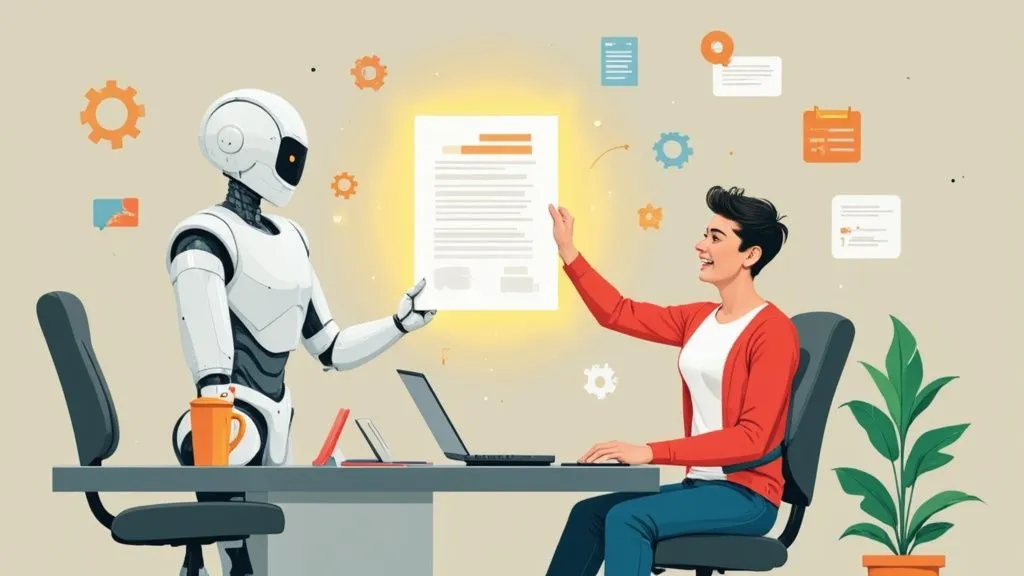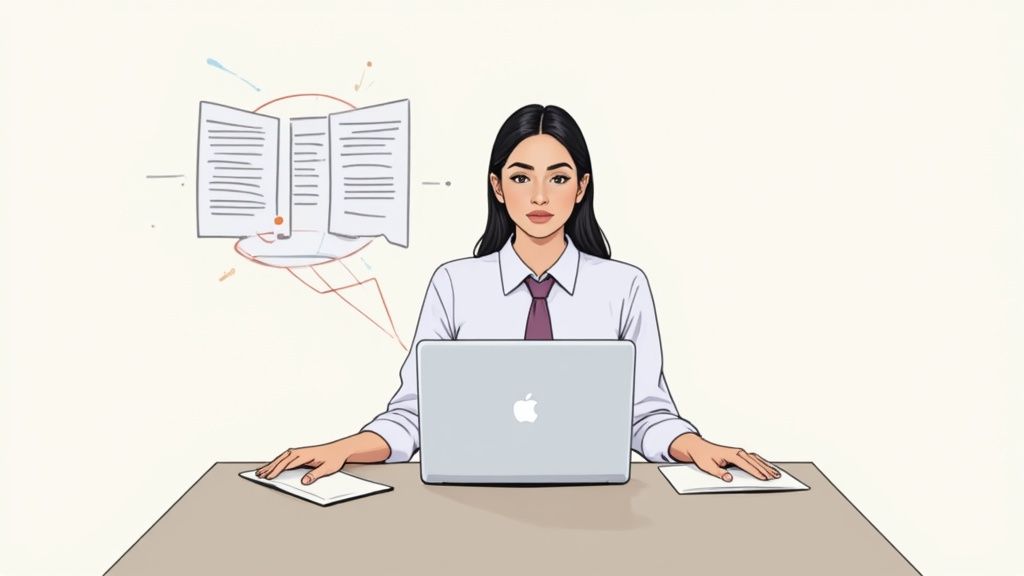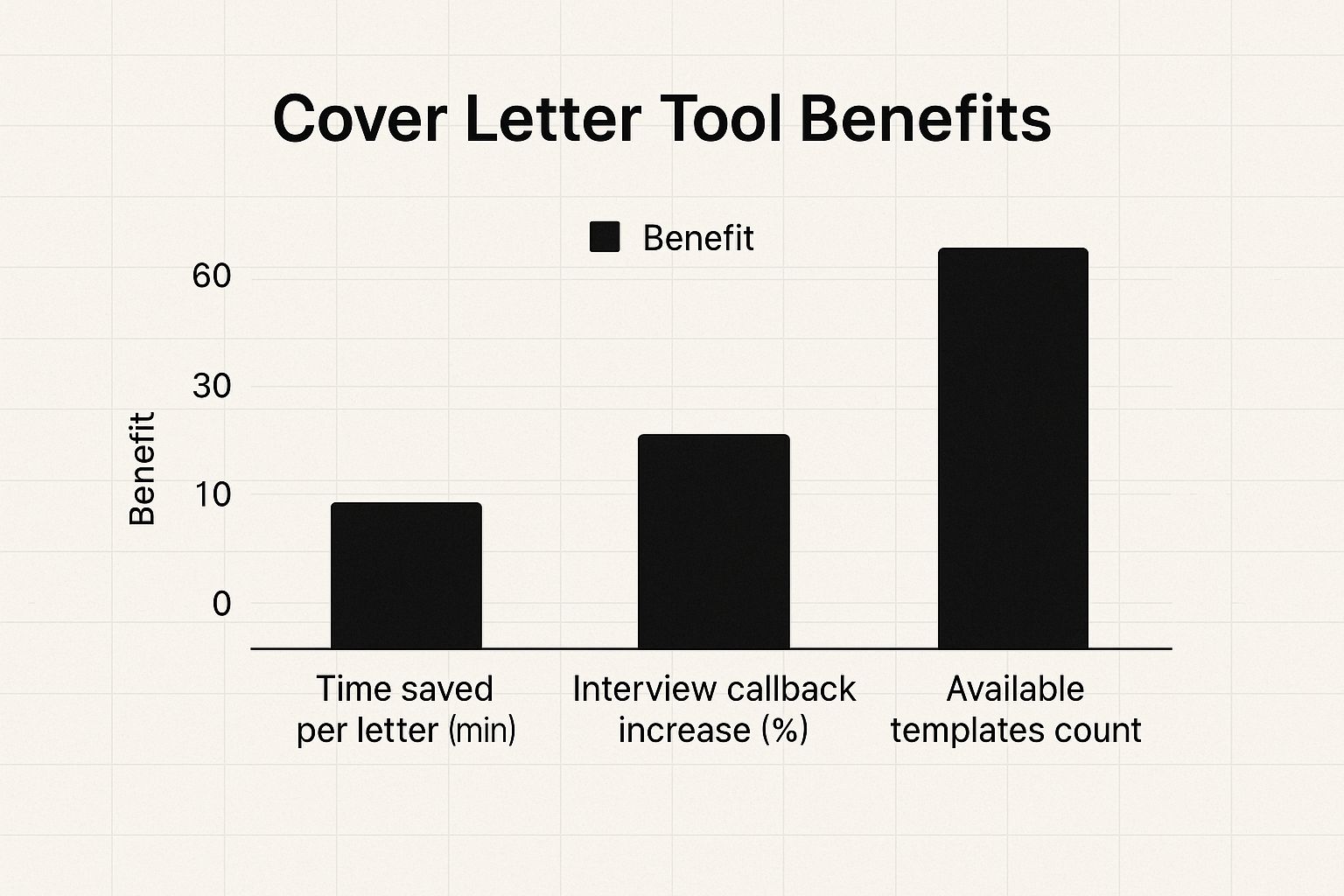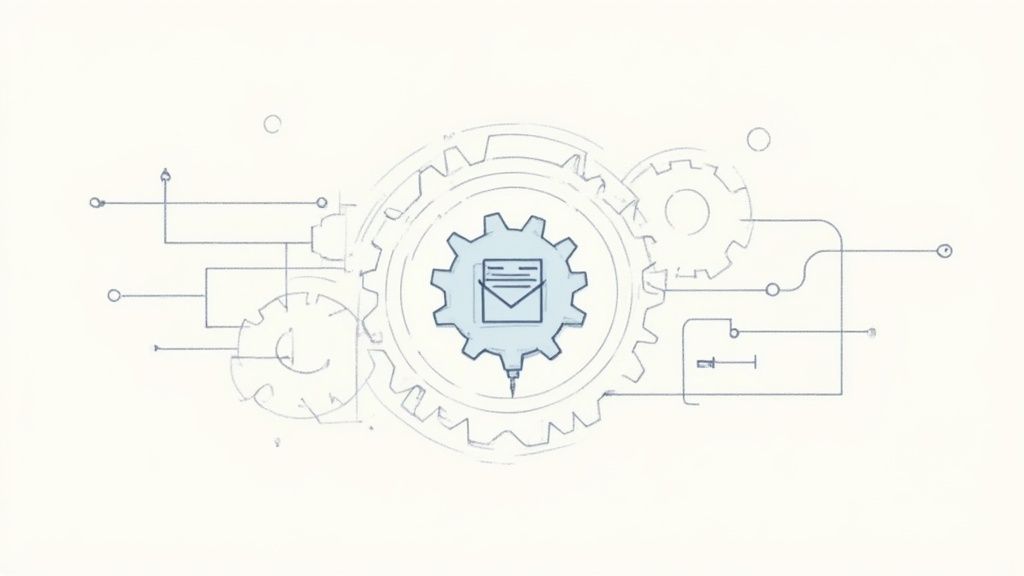
Using an AI Cover Letter Generator to Land Interviews
An AI cover letter generator is a tool that uses artificial intelligence to help you write personalized cover letters, often in just a few minutes. It’s a great way to get past writer’s block and create applications tailored to specific jobs. These platforms work by looking at your resume and the job description, then producing keyword-rich content that’s built to get noticed by automated screening systems.
Why Your Cover Letter Strategy Needs an Upgrade

Let’s be honest: writing cover letters is a grind. It’s easily one of the most tedious and time-consuming parts of any job search. The old-school advice to spend hours crafting a brand-new, unique letter for every single application just doesn’t work anymore, especially when you’re firing off applications for dozens of different roles. That approach simply doesn’t scale.
The hard truth of today’s job market is that your application is almost always screened by an Applicant Tracking System (ATS) first. These systems are programmed to scan for specific keywords and phrases directly from the job description. If your cover letter is missing those key terms, there’s a good chance a human hiring manager will never even lay eyes on it.
The Rise of Intelligent Application Tools
This is exactly where an AI cover letter generator can completely change your job search. Instead of staring at a blinking cursor on a blank page, you can get a relevant, tailored first draft in seconds. These tools are far more than simple template fillers; they use natural language processing to actually understand what a job role requires and highlight the skills you have that matter most.
Think of it as having a personal writing assistant who already knows what the recruiter is looking for. The benefits become pretty clear, pretty quickly:
- Save a Ton of Time: You can cut down the time you spend on each application from hours to just a few minutes.
- Get Past the Robots: AI tools automatically weave in the critical keywords needed to pass that initial ATS screening.
- Beat Writer’s Block: Instantly generate a solid foundation that you can then tweak and personalize.
- Maintain Professional Quality: Every cover letter you send out will be well-structured, professional, and free of embarrassing typos.
The goal here isn’t to replace your voice but to enhance it. AI handles the heavy lifting—the structure, the keyword matching—so you can focus on injecting your unique personality and telling your most compelling career stories.
A Smarter Way to Job Hunt
Using these tools is rapidly becoming a standard part of the modern job hunt. The adoption of AI cover letter generators has shot up, with platforms like CoverDoc.AI becoming popular among savvy job seekers. Many of these services let you generate a few personalized letters for free or offer affordable plans, giving a real boost to both the quality of your applications and your confidence.
This really marks a fundamental shift in how we should be thinking about job applications. It’s all about making the process more efficient and, ultimately, more effective. You can learn more about some of the top tools for job seekers and find one that works for you.
How to Choose the Right AI Generator for Your Career
With a new AI cover letter generator popping up every other week, it’s easy to get lost in the noise. The trick is to ignore the flashy marketing and zero in on what actually gets you in the door for an interview.
Think of it this way—not all tools are built the same because not all job hunts are the same. A software engineer gunning for a spot at a fast-paced startup has a completely different set of needs than a marketing director aiming for a Fortune 500 company. One needs to showcase technical projects, while the other has to nail brand storytelling and campaign metrics. The right tool understands that difference.
Evaluate Core Features and Functionality
Before you hand over your email address for a free trial, take a hard look at the tool’s core capabilities. A slick design means nothing if the cover letters it produces are generic and robotic. Your evaluation should really come down to a few key areas that make or break your application.
Here are the absolute must-haves:
- Resume and Job Description Integration: The best generators let you feed them your resume and the job description. Without that context, the AI is just guessing. This is the only way to get a letter that truly connects your experience to what the hiring manager is looking for.
- ATS Optimization Quality: Any decent tool will sprinkle in keywords. The great ones weave them in so naturally you can’t even tell. A quick test is to see if the output reads like a human wrote it or like a machine just crammed a bunch of buzzwords into sentences.
- Customization and Editing Control: Let’s be clear: you should never send an AI-generated letter without putting your own spin on it. A good platform makes this easy. It should give you full control to tweak the tone, drop in a personal story, and make sure the final product sounds like you.
A great AI tool doesn’t just write for you; it collaborates with you. It should provide a strong, optimized foundation that saves you time, but you remain the final editor responsible for adding authenticity and personal flair.
This chart really drives home how much of an impact these tools can have, from cutting down application time to actually getting more calls back from recruiters.

The numbers speak for themselves. The time you get back and the potential for more interviews make a solid case for adding one of these generators to your job-seeking toolkit.
A side-by-side look can help clarify which platform might be the best fit for your specific needs.
Feature Comparison of Leading AI Cover Letter Generators
| Generator | Key Feature | ATS Optimization | Customization Level | Pricing Model |
|---|---|---|---|---|
| Kickresume | Integrated with resume builder | Strong keyword matching | High | Freemium |
| Rezi | Real-time content analysis | Excellent, built-in scanner | High | Freemium |
| Jobscan | Focus on ATS matching score | Industry-leading | Medium | Subscription |
| Grammarly | AI generation with grammar check | Good | Medium | Freemium |
Ultimately, the best choice depends on how aggressively you’re job hunting and whether you need features like a built-in ATS scanner or advanced template options.
Free Plans Versus Paid Subscriptions
Ah, the classic “free vs. paid” dilemma. Free versions are fantastic for taking a tool for a test drive or if you’re only applying for a couple of jobs here and there. They let you get a feel for the platform without pulling out your credit card.
But if you’re serious about your job search, a paid plan often pays for itself pretty quickly.
Free plans usually cap you at a few cover letters a month and stick you with basic templates. Upgrading to a premium subscription is where you unlock the real power:
- Unlimited Generations: This is a lifesaver if you’re applying to multiple roles every week.
- Advanced Templates: Get access to more professional, industry-specific designs that help you stand out.
- Tone and Style Adjustments: The ability to easily switch the letter’s vibe from buttoned-up corporate to something more creative is a game-changer.
Some platforms, like Grammarly, even build their top-notch writing assistants right into the generator. You can upload your resume, paste the job details, and get a surprisingly natural-sounding draft in under 15 seconds.
By thinking about how many applications you’re sending and what features you truly need, you can pick a tool that will genuinely help you move forward in your career.
Generating Your First High-Impact Draft

Okay, this is where all that prep work really starts to shine. Using an AI cover letter generator isn’t magic—it’s not about just clicking a button and hoping for gold. It’s about feeding the machine the right ingredients to get a powerful, nearly-finished draft in a matter of minutes.
The quality of what you get out is a direct reflection of the quality of what you put in.
Before you even think about opening the AI tool, get your two most important documents ready: your updated resume and the specific job description. Think of it this way: the AI will scan your resume to understand your history, skills, and wins. Then, it will use the job description as a treasure map to figure out what the employer actually cares about.
Crafting the Perfect Prompt
Your prompt is your instruction manual for the AI. Imagine you’re talking to a brilliant but very literal assistant. Just pasting your resume and the job description is a decent start, but a little extra direction can completely change the game. You’re trying to guide the AI toward the specific story you want to tell.
A solid prompt usually includes a few key things:
- Set the Tone: Do you want to sound buttoned-up and corporate? Or energetic and creative? Tell the AI. For a role at a fast-moving tech startup, you might ask for a “passionate and forward-thinking tone.”
- Point to Your Wins: Don’t make the AI guess which of your accomplishments is the most relevant. Call it out directly. For example, “Make sure to highlight my experience boosting Q3 sales by 15% with that new social media strategy.”
- Connect to Company Values: This shows you’ve actually done your homework. If the company’s mission statement is all about “sustainability” or “community impact,” ask the AI to link one of your past projects to that specific value.
A well-crafted prompt is the bridge between your raw data (the resume) and the company’s wish list (the job description). It’s what turns a generic summary into a persuasive pitch that screams, “I’m the one you’ve been looking for.”
This is the secret sauce that separates a robotic, forgettable letter from one that feels targeted and genuinely personal.
Providing the Right Inputs for Stronger Results
Once your prompt is dialed in, it’s time to give the information to your AI cover letter generator. The best tools, like our own at Jobcamp, have dedicated fields for you to upload your resume and paste the job description. This structured approach is vital for getting an accurate result.
Resist the urge to just copy and paste a giant wall of text from your LinkedIn profile. A clean, properly formatted resume document works so much better. It helps the AI correctly parse your job titles, employment dates, and key duties without getting tripped up. The cleaner the input, the more coherent and relevant the output.
For instance, instead of one long, messy paragraph, make sure your experience is laid out clearly:
- Project Manager, ABC Corp (2020-Present): Led a team of five to deliver a client software project two weeks ahead of schedule.
- Marketing Associate, XYZ Inc (2018-2020): Managed a $50,000 digital ad budget, increasing lead generation by 25% year-over-year.
When you format your info like this, the AI can easily pull out those juicy, quantifiable achievements and map them directly to what the job description is asking for.
The result is a draft that isn’t just a boring summary of your past—it’s a direct, compelling response to what the employer needs right now. The whole point here is to get you 80% of the way there with an optimized draft, setting the stage for you to add that final, crucial human touch.
Don’t Send That AI-Generated Letter Just Yet: Here’s How to Add the Human Touch
You’ve used an AI cover letter generator to get a solid first draft. It’s got the right structure, it’s peppered with keywords, and the tone feels professional. It’s a fantastic starting point, but hitting “send” right now is a huge mistake.
Think of that draft as 80% of the way there. The final 20% is where you come in. This is where you add your unique human touch—the part that actually gets a hiring manager to sit up and pay attention.
An AI is great at matching your resume to the job description, but it can’t tell a story. It has no idea about the passion that fueled that project you led, or the specific hurdle you cleared to hit that impressive number. This final edit is where you turn a technically correct document into a genuinely persuasive pitch.
Find Your Voice (The AI Can’t)
The dead giveaway of a purely AI-written letter is its sterile, almost robotic perfection. Your first job is to mess it up a bit by injecting your own personality. A simple trick? Read the letter out loud. If it doesn’t sound like something you’d actually say, it’s time to rewrite.
For instance, the AI might generate something like this: “I successfully executed a marketing campaign that resulted in a 25% increase in user engagement.”
It’s technically correct, but it’s completely devoid of life. A little human flair makes it far more memorable: “I was so proud to lead our ‘Summer Splash’ campaign from the initial concept all the way to launch. By taking a chance on a new user demographic on TikTok, we didn’t just meet our goals—we blew past them, boosting engagement by 25% in just six weeks.”
See the difference? The second version has energy. It tells a mini-story that a hiring manager can actually connect with. That’s something only you can provide.
Your personality is the one thing no AI can replicate. Weaving it into your cover letter is what closes the gap between being just another qualified applicant and being someone they genuinely want to meet.
Match the Company’s Vibe
Beyond your own voice, the letter has to feel right for the company you’re applying to. Most AI cover letter generators will default to a safe, formal tone. That’s perfect if you’re applying to a buttoned-up law firm, but it’ll fall completely flat for a quirky ad agency or a fast-moving tech startup.
You have to adjust the tone to fit the culture.
- Applying for a Corporate Role? Keep the language professional, but add a quick, specific story that highlights your problem-solving skills within a structured team.
- Aiming for a Startup? Use more energetic, action-oriented words. Talk about their mission, why it excites you, and how your scrappy, adaptable nature will help them scale.
- Eyeing a Creative Position? Let your personality shine. You could even mention a specific campaign of theirs that you loved and explain why it caught your eye.
This step is absolutely critical. As the career experts at LiveCareer point out, while AI tools are trusted for creating professional, ATS-friendly documents, human oversight is non-negotiable for adding this level of personalization and cultural fit.
The Final Fact-Check and Polish
Last but not least, you need to go over the draft with a fine-tooth comb. AI is incredibly smart, but it’s not perfect. It can sometimes misinterpret a bullet point from your resume or slightly inflate a metric. It’s on you to ensure every single detail is 100% accurate.
Pay close attention to these areas:
- Your Numbers: Did the AI get your stats right? Was it 15% growth or 18%? Precision builds credibility.
- Proper Nouns: Double-check the spelling of everything—project names, software, past campaign titles. Small mistakes look sloppy.
- The “Why”: The AI is great at explaining what you did. Your job is to add the why. Why are you passionate about this work? And why is this specific role at this specific company the perfect next step for you?
When you layer your personal stories, authentic voice, and meticulous fact-checking on top of a strong AI foundation, you get the best of both worlds: a cover letter that’s optimized for algorithms but irresistible to humans.
Advanced Tactics for Beating Applicant Tracking Systems

Let’s be honest, the toughest gatekeeper you’ll face is often a piece of software. It’s a harsh reality that over 75% of resumes are kicked out by an Applicant Tracking System (ATS) before a real person ever lays eyes on them. This is exactly where you can turn your AI cover letter generator into a secret weapon.
But it’s not about just jamming keywords into a template. Today’s ATS is more sophisticated; it’s searching for context and relevance, not just buzzwords. Your mission is to craft a cover letter that sails through the initial scan and impresses the hiring manager on the other side. This takes a bit more thought than simply hitting “generate.”
Mastering Keyword Integration
Your first move is to have the AI scan the job description to pull out the essential keywords. Don’t stop at the obvious hard skills like “SEO” or “Python.” Look deeper for the soft skills and action verbs the company emphasizes—words like “innovate,” “spearhead,” or “collaborate.”
Once you have that list, your job is to weave those terms into your story so they feel authentic. For instance, if the posting keeps mentioning “cross-functional collaboration,” a basic AI draft might give you this:
- AI Draft: “I have experience with cross-functional collaboration.”
It’s fine, but it’s flat. A little human insight makes it sing.
- Your Edit: “My proudest moments often come from leading cross-functional collaborations, like when I brought our engineering and marketing teams together to launch the new app ahead of schedule.”
See the difference? The second version doesn’t just state the skill; it proves it with a mini-story. That’s what catches the attention of both a smart ATS and a human reader.
The goal isn’t to trick the system. It’s to show—using the company’s own language—that your skills and experience are a direct match for what they’re looking for.
Formatting for the Machines
Even a perfectly worded cover letter will get you nowhere if the ATS can’t parse it. This is where many applicants stumble. Fancy templates with columns, text boxes, or funky headers might look cool, but they can completely scramble your content in an ATS.
Pay attention to the small technical details that make a huge difference:
- Stick to Standard Fonts: Play it safe with universal, sans-serif fonts like Arial, Calibri, or Helvetica. They’re easy for any system to read.
- Ditch the Graphics: Leave out your headshot, personal logos, or any other images. The ATS can’t read them and they can cause parsing errors.
- Use Standard Headings: Simple, direct headers like “Professional Experience” or “Skills” work much better than trying to get creative.
Finally, the file type matters. Always save and submit your cover letter as a .docx or .pdf file. While a PDF perfectly preserves your layout for a person, some older ATS versions can struggle with it. If the application gives you the option, .docx is usually the safest bet for compatibility. Getting these technical points right ensures your message actually gets through.
Common Questions About AI Cover Letter Tools
Jumping into any new tech always brings up a few questions, and using an AI cover letter generator is no exception. It’s smart to wonder if you’re actually helping your job search or just raising red flags. Let’s dig into some of the most common concerns I hear from job seekers.
The number one question is always: “Will a recruiter know I used AI?” It’s a valid fear. Early AI writing was definitely clunky and easy to spot. These days, though, the technology has gotten surprisingly good at sounding natural.
But here’s the catch: a completely unedited, raw output from any AI tool can still feel a bit soulless. It often lacks the personal stories and genuine voice that make a candidate truly stand out to a hiring manager. The trick is to treat the AI draft as a really solid first draft, not the final copy.
Can Recruiters Tell if a Cover Letter Was Written by AI?
Honestly, an unedited AI letter can sometimes look too perfect. The structure might be flawless, but it won’t have the specific anecdotes or personality that connect with a real person. A seasoned recruiter might not think “AI,” but they’ll definitely think “generic.”
This is where you come in. By weaving in your own achievements, tweaking the tone to match the company’s vibe, and triple-checking every detail, you scrub away any hint of automation. You’re simply blending the AI’s speed with your own authentic story. The final product becomes uniquely yours, and no one will be the wiser.
Are AI Cover Letter Generators Safe for Personal Data?
This is a big one, and you’re right to be cautious. Any reputable platform takes data privacy seriously. They should only be using the info from your resume and the job description for one thing: generating your cover letter. They definitely shouldn’t be selling your professional history to advertisers.
Before you upload anything, take a minute to skim the tool’s privacy policy. It’s a simple step that gives you peace of mind, letting you know exactly how your data is being handled.
As a general rule, just stick to the professional information you’d normally put on an application. There’s no need to input any super-sensitive personal details anyway.
Is It Worth Paying for a Premium AI Generator?
This really depends on how hard you’re hitting the job search. If you’re just dipping your toes in or applying to a couple of roles, a free version is perfect. It lets you get a feel for how the tool works without spending a dime.
But if you’re in full-on job hunt mode and sending out applications every week, a premium plan can be a game-changer. The small investment often pays for itself by unlocking features that seriously speed things up and boost your response rate.
Paid plans usually get you:
- Unlimited cover letters, which is essential for applying at scale.
- More professional templates to choose from.
- Tone and style adjusters to better match each specific company.
- Better grammar and plagiarism checks for that final, crucial polish.
For anyone serious about their search, the monthly fee is often a small price to pay for saving hours of tedious work and, most importantly, landing more interviews.
Ready to create compelling, ATS-optimized cover letters in minutes? Jobcamp uses AI to craft personalized applications that get you noticed. Stop staring at a blank page and start landing more interviews. Try Jobcamp for free today!

